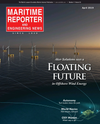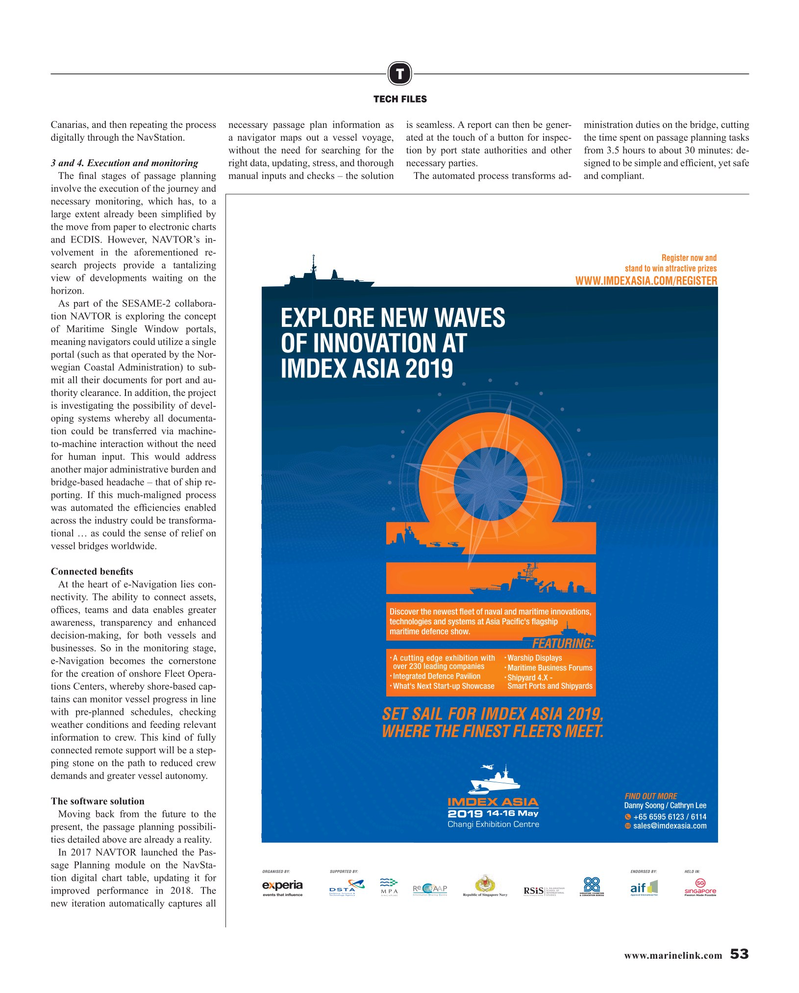
Page 53: of Maritime Reporter Magazine (April 2019)
Navies of the World
Read this page in Pdf, Flash or Html5 edition of April 2019 Maritime Reporter Magazine
T
TECH FILES
Canarias, and then repeating the process necessary passage plan information as is seamless. A report can then be gener- ministration duties on the bridge, cutting digitally through the NavStation. a navigator maps out a vessel voyage, ated at the touch of a button for inspec- the time spent on passage planning tasks without the need for searching for the tion by port state authorities and other from 3.5 hours to about 30 minutes: de- 3 and 4. Execution and monitoring right data, updating, stress, and thorough necessary parties. signed to be simple and ef? cient, yet safe
The ? nal stages of passage planning manual inputs and checks – the solution The automated process transforms ad- and compliant.
involve the execution of the journey and necessary monitoring, which has, to a large extent already been simpli? ed by the move from paper to electronic charts and ECDIS. However, NAVTOR’s in- volvement in the aforementioned re- search projects provide a tantalizing view of developments waiting on the horizon.
As part of the SESAME-2 collabora- tion NAVTOR is exploring the concept of Maritime Single Window portals, meaning navigators could utilize a single portal (such as that operated by the Nor- wegian Coastal Administration) to sub- mit all their documents for port and au- thority clearance. In addition, the project is investigating the possibility of devel- oping systems whereby all documenta- tion could be transferred via machine- to-machine interaction without the need for human input. This would address another major administrative burden and bridge-based headache – that of ship re- porting. If this much-maligned process was automated the ef? ciencies enabled across the industry could be transforma- tional … as could the sense of relief on vessel bridges worldwide.
Connected bene? ts
At the heart of e-Navigation lies con- nectivity. The ability to connect assets, of? ces, teams and data enables greater awareness, transparency and enhanced decision-making, for both vessels and businesses. So in the monitoring stage, e-Navigation becomes the cornerstone for the creation of onshore Fleet Opera- tions Centers, whereby shore-based cap- tains can monitor vessel progress in line with pre-planned schedules, checking weather conditions and feeding relevant information to crew. This kind of fully connected remote support will be a step- ping stone on the path to reduced crew demands and greater vessel autonomy.
The software solution
Moving back from the future to the present, the passage planning possibili- ties detailed above are already a reality.
In 2017 NAVTOR launched the Pas- sage Planning module on the NavSta- tion digital chart table, updating it for improved performance in 2018. The new iteration automatically captures all www.marinelink.com 53
MR #4 (50-58).indd 53 4/2/2019 2:10:53 PM

 52
52

 54
54
